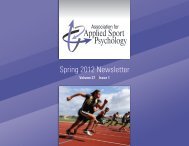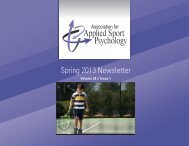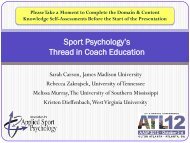Performance Excellence Movement - Association for Applied Sport ...
Performance Excellence Movement - Association for Applied Sport ...
Performance Excellence Movement - Association for Applied Sport ...
Create successful ePaper yourself
Turn your PDF publications into a flip-book with our unique Google optimized e-Paper software.
<strong>Per<strong>for</strong>mance</strong> <strong>Excellence</strong> <strong>Movement</strong><br />
December 2009; Vol. 6(1)<br />
much more powerful than the Palestinians; thus, they want to solve the problems their way) and; (d) there<br />
is dehumanization of the “other” (i.e., by the age of four or five Israeli and Palestinian children “know<br />
who the enemy is” (personal communication, S. Munayer, July 9, 2006). Even more so, conducting a<br />
sport camp involving conflict resolution and teambuilding between Israeli and Palestinian girls is<br />
complicated by the fact that both Israelis and Palestinians are victims. Un<strong>for</strong>tunately, the current conflict<br />
is the result of neither groups’ doing nor responsibility (personal communication, S. Munayer, July 9,<br />
2006). In addition, neither group sees their personal attitudes towards the conflict as part of the problem.<br />
Thus, it was the task of American, Palestinian and Israeli counselors to collaborate to bring young girls<br />
together regardless of nationality or religion. It was our mission to show them their commonalities, not<br />
their differences. In addition, as an American it was imperative that I realized and was sensitive to the<br />
fact that coming into this camp, I was coming from the most powerful and dominant group. Along these<br />
lines, it was important <strong>for</strong> me to recognize that as a counselor silence on my part meant approval;<br />
there<strong>for</strong>e, it was vital that I acknowledged and noted the unique perspectives of all the campers. Likewise,<br />
I needed to ignore the imbalance of power and understand that both Palestinians and Israelis felt<br />
incredibly rejected. This feeling of rejection was real and, thus, the bottom line was that all campers<br />
needed and wanted to be accepted <strong>for</strong> who they were and to be loved (personal communication, S.<br />
Munayer, July 9, 2006).<br />
I recall vividly when campers entered the cafeteria on the first day of camp. While I spoke neither<br />
Hebrew nor Arabic, the divide between Israeli and Palestinian was undeniable, noticeable by stares and<br />
groupings of “others”. Yet, day-by-day, hour-by-hour and activity-by-activity, communication and<br />
cultural exchange between the Israeli and Palestinian girls increased through sport. The girls played<br />
ultimate Frisbee, basketball, and volleyball together on teams. They paired up, one Palestinian and one<br />
Israeli, and competed against other teams in blindfolded obstacle courses and scavenger hunts. We<br />
discussed body image, played “Two truths and a lie”, made a human knot which the girls had to work<br />
together to untangle, wrote team rules, and decided on team mascots and chants. Soon, it became more<br />
difficult to see the difference between Israeli and Palestinian girls.<br />
With regard to sport, the young girls could not imagine having<br />
the opportunity I had had as an American girl growing up<br />
involved in basketball, soccer, baseball, and track. While the boys<br />
in Palestine and Israel had school-sponsored teams at their middle<br />
and high schools, the girls had club teams where at maximum<br />
they played six to eight games per year. Often times, there were<br />
few sports to choose to play. While some had high passion to<br />
learn and play others did not; however, all of their skills were<br />
lower than or equivalent to those of the average athletic skill level<br />
of young girls in the United States.<br />
It was inspiring to see their desire to compete despite their lack of opportunity and skill<br />
development. My belief that sport psychology could be used <strong>for</strong> more than just assisting elite athletes in<br />
attaining their peak per<strong>for</strong>mance was reified. We set goals and established affirmation statements to<br />
build confidence and help track improvement. I then became convinced, in fact, that sport psychology<br />
could be used in non-historical ways to foster relationships otherwise seen as impossible amongst<br />
children who had been taught to hate one another.<br />
In discussion activities the values, stereotypes and goals of these girls were brought up. These<br />
discussions often times became emotionally draining yet enlightening. They challenged all of us,<br />
counselors and campers, to get out of our com<strong>for</strong>t zones and share. One of many examples was when<br />
the girls participated in a word association activity. We began the activity by having the girls state the<br />
first things they heard of when they heard the words “rich,” “pretty teeth,” “greedy,” “stuck up,”<br />
11






